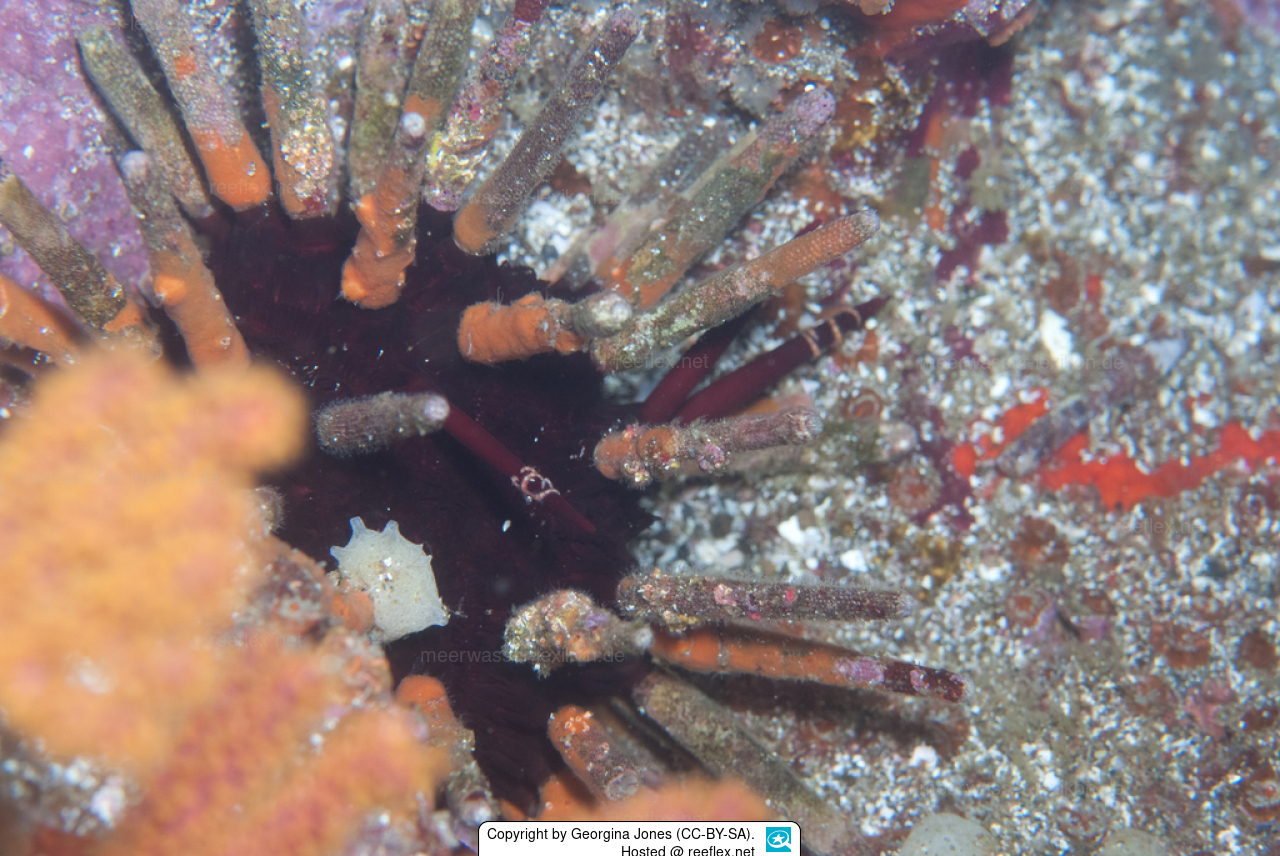Info
Eucidaris galapagensis Döderlein, 1887
The type locality for the description of Eucidaris galapagensis is the Galapagos Islands. The species name “ galapagensis” refers to the type locality.
This sea urchin lives in coastal areas on the Galapagos, Clipperton and Cocos Islands. The preferred substrate is rocky, benthic environments that provide shelter. Eucidaris galapagensis feeds mainly on plants, but also eats various invertebrates and also corals. They graze heavily on live coral and algae in open, shallow reef habitats.
Eucidaris galapagensis is mainly nocturnal. In addition, they can perceive ambient light using photoreceptor cells, which act as their visual system.
Echinoderms are important components of marine communities, and Eucidaris galapagensis is no exception. The spines of sea urchins provide a habitat for diverse epifauna. A significant proportion, 90%, of sea urchin spines are encrusted with diverse epifauna. A single lance urchin can harbor over 20 species.
Eucidaris galapagensis can be strongly affected by climatic events such as El Niño and climate change. However, Eucidaris galapagensis are adapted and acclimatized to short-term, local temperature fluctuations and have a much higher thermal tolerance. Habitats suffering from climate impacts can be infiltrated by Eucidaris galapagensis, resulting in “urchin barrens”, desolate, overgrazed coral reefs overgrown by algae. An oversupply of urchins can affect the formation of reef structure and thus reduce reef growth.
Populations of Eucidaris galapagensis in warmer locations have been found to have a higher tolerance to higher temperatures, indicating a certain ability to adapt and acclimatize to warming oceans. This finding may also help to explain why this ubiquitous species is so successful throughout the Galapagos archipelago and thrives in a wide range of environmental conditions.
Translated with DeepL.com (free version)
Synonymised names
Cidaris (Eucidaris) galapagensis Döderlein, 1887 · unaccepted > superseded combination
Eucidaris thouarsii galapagensis (Döderlein, 1887) · unaccepted > superseded combination
The type locality for the description of Eucidaris galapagensis is the Galapagos Islands. The species name “ galapagensis” refers to the type locality.
This sea urchin lives in coastal areas on the Galapagos, Clipperton and Cocos Islands. The preferred substrate is rocky, benthic environments that provide shelter. Eucidaris galapagensis feeds mainly on plants, but also eats various invertebrates and also corals. They graze heavily on live coral and algae in open, shallow reef habitats.
Eucidaris galapagensis is mainly nocturnal. In addition, they can perceive ambient light using photoreceptor cells, which act as their visual system.
Echinoderms are important components of marine communities, and Eucidaris galapagensis is no exception. The spines of sea urchins provide a habitat for diverse epifauna. A significant proportion, 90%, of sea urchin spines are encrusted with diverse epifauna. A single lance urchin can harbor over 20 species.
Eucidaris galapagensis can be strongly affected by climatic events such as El Niño and climate change. However, Eucidaris galapagensis are adapted and acclimatized to short-term, local temperature fluctuations and have a much higher thermal tolerance. Habitats suffering from climate impacts can be infiltrated by Eucidaris galapagensis, resulting in “urchin barrens”, desolate, overgrazed coral reefs overgrown by algae. An oversupply of urchins can affect the formation of reef structure and thus reduce reef growth.
Populations of Eucidaris galapagensis in warmer locations have been found to have a higher tolerance to higher temperatures, indicating a certain ability to adapt and acclimatize to warming oceans. This finding may also help to explain why this ubiquitous species is so successful throughout the Galapagos archipelago and thrives in a wide range of environmental conditions.
Translated with DeepL.com (free version)
Synonymised names
Cidaris (Eucidaris) galapagensis Döderlein, 1887 · unaccepted > superseded combination
Eucidaris thouarsii galapagensis (Döderlein, 1887) · unaccepted > superseded combination







 Georgina Jones (CC-BY-SA), Cape Town
Georgina Jones (CC-BY-SA), Cape Town






